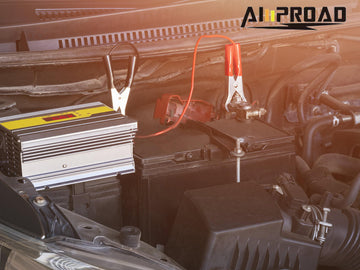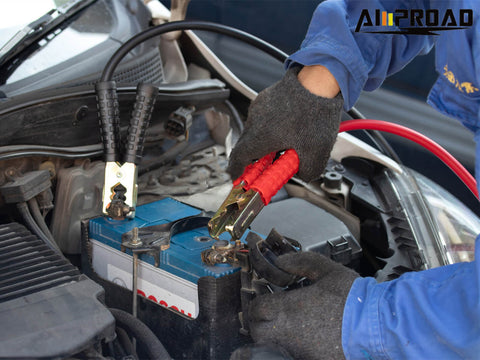
The process of jump-starting a car traditionally requires careful handling and technical knowledge, as improper use of jumper cables with donor vehicles can lead to hazardous situations including sparks, short circuits, or damage to vehicle electronics. Modern power bank jump starters have transformed this potentially risky task into a more accessible solution, eliminating the need for complex cable connections between vehicles and providing a safer, more user-friendly approach that particularly benefits those less familiar with conventional jump-starting procedures.
Preparation and Connection Steps
Ensuring a smooth and successful jump-start with a power bank involves careful preparation and precise connection steps. Here's a detailed guide to navigate these crucial aspects:
And before initiating the jump-start process, it's imperative to check the charge level of the power bank. An adequately charged power bank ensures a reliable power source for jump-starting the car. Most power banks designed for jump-starting purposes come with indicator lights or a display to convey their charge status. Ensure that the power bank has sufficient charge to deliver the necessary boost to the vehicle's battery.
Identifying and Connecting the Jump Starter Cables

Next, identify the jump starter cables included with the power bank. These cables typically feature distinctive colors or markings to distinguish between positive (+) and negative (-) terminals. It's crucial to correctly identify these terminals on both the power bank and the car battery.
Begin by connecting the red cable to the positive terminal of the car battery. The positive terminal is usually marked with a "+" sign and may be red. Once securely connected, attach the other end of the red cable to the corresponding positive terminal on the power bank.
Proceed to connect the black cable to the negative terminal of the car battery. The negative terminal is typically marked with a "-" sign and may be black. Similarly, attach the other end of the black cable to the corresponding negative terminal on the power bank.
Ensuring a firm and secure connection is vital at this stage. Be cautious to avoid contact between the red and black cables during the process to prevent any short circuits.
With the jump starter cables securely connected, activate the power bank according to the manufacturer's instructions. This often involves pressing a button or switch to initiate the jump-start function.
Once activated, attempt to start the car. If successful, disconnect the jumper starter cables in the reverse order of connection, starting with the black (negative) cable from the car battery.
By meticulously following these preparation and connection steps, you can leverage a power bank jump starter confidently and effectively, ensuring a safe and expedient solution for jump-starting your vehicle.
Related Content: How to Boost a Car
Jump-Starting Your Car Safely with a Power Bank Jump Starter
Facing a dead car battery can be stressful, but a power bank jump starter offers a modern and convenient solution. Here's a comprehensive guide to seamlessly navigate the jump-starting process while prioritizing safety.
Begin by ensuring a safe environment – park both vehicles in a well-ventilated area away from traffic and turn off all electronic devices in the dead vehicle. Under the hood, locate the car battery and familiarize yourself with the positive (+) and negative (-) terminals.
Activate the car battery power bank jump starter following the manufacturer's instructions. Confirm sufficient charge through indicator lights. Connect the red cable to the positive terminal of the car battery and the corresponding terminal on the power bank. Then, connect the black cable to the negative terminal of the car battery and the power bank.
Attempt to start the vehicle. If successful, proceed to disconnect the cables in the reverse order. Begin with the black (negative) cable from the car battery, followed by the corresponding cable on the power bank. Finally, disconnect the red (positive) cable from the car battery and the power bank.
Allow the engine to run for a few minutes to recharge the car battery through the alternator. This step is crucial for ensuring ample charge for the next start.
Emphasizing safety throughout the process is paramount. Avoid contact between the red and black cables to prevent sparks or short circuits. If the jump-start is unsuccessful initially, wait before attempting again. Consult your vehicle's manual or seek professional assistance if uncertain.

Mastering the jump-starting process with a power bank provides a reliable and safe solution for unexpected battery issues. By following this guide, you can confidently address a dead battery situation, ensuring a quick and secure solution on the road.
Troubleshooting Common Power Bank Issues
Power banks stand out as indispensable devices. They serve as reliable companions for keeping our smartphones, tablets, and other gadgets charged on the go. However, like any electronic device, power banks can encounter issues. Understanding common problems and their potential solutions ensures you get the most out of your portable power source.
If your power bank doesn't seem to hold a charge as it used to, the battery may be aging. Rechargeable batteries have a limited lifespan, and over time, their capacity diminishes. Consider replacing the power bank if its charging capacity becomes insufficient for your needs.
Slow charging could be due to using a low-power charger or cable. Ensure you're using a charger that matches your power bank's specifications, and opt for high-quality charging cables. Additionally, charging multiple devices simultaneously may slow down the overall charging speed.
Power banks may heat up during charging or discharging, but excessive heat can be a concern. Avoid leaving your power bank in direct sunlight or hot environments, as high temperatures can damage the battery. If overheating persists, it could be a sign of a malfunctioning battery, and professional assistance may be required.
If your power bank is charging intermittently or not at all, inspect the charging port and cable for debris or damage. Cleaning the port and using a different cable can often resolve this issue. If problems persist, the charging port may need repair or replacement.
Power banks occasionally shut down unexpectedly. This may be due to a software glitch or a safety feature triggered by overheating or overcharging. Resetting the power bank or allowing it to cool down before recharging can often resolve this issue.
If your power bank struggles to hold a charge for an extended period, it may be a result of aging batteries. Consider replacing the power bank or seeking professional advice if the issue persists.
Ensure your power bank is compatible with the devices you intend to charge. Some devices require a higher voltage or wattage, and using an incompatible power bank may lead to inefficient charging or device malfunction.
Troubleshooting these common power bank issues allows you to address challenges effectively, ensuring your portable power source remains a dependable ally in keeping your devices charged and ready for action.
How to Choose the Best Jump Starter?
Selecting the perfect starter jumper is a crucial decision for vehicle owners, offering a dependable solution for unexpected battery challenges. As you embark on this decision-making journey, consider factors that seamlessly integrate with your specific needs and usage.
Start by evaluating the power capacity of the jump starter, typically measured in peak amps. A higher peak amp rating signifies the ability to jump-start larger engines. Ensuring that the car jump starter aligns with your vehicle's engine size is a fundamental step toward effectiveness.
Consider the type of battery your vehicle uses, whether lead-acid or lithium-ion. Compatibility between the jump starter and your vehicle's battery type is paramount for a successful jump-starting process.
Opt for a car battery booster that prioritizes portability and convenience. A compact, portable design not only makes it easy to carry but also ensures it won't take up excessive space in your vehicle.
When considering reliable options, Amproad stands out as a leading jump starter manufacturer. Their innovative and efficient designs cater to various vehicle needs, providing a trustworthy solution for on-the-go battery challenges.

Safety features should be a priority, including reverse polarity protection and short-circuit protection. These features play a crucial role in preventing accidents and safeguarding your vehicle's electrical system during the jump-starting process.
Explore additional features that enhance usability. Built-in lights for nighttime emergencies, USB ports for charging devices, and air compressors for tire inflation can add versatility to the jump starter's functionality.
Prioritize user-friendly designs. Clear instructions, intuitive controls, and visible indicators contribute to a seamless jump-starting experience, especially for those less familiar with automotive maintenance.
Assess the durability of the jumper starter. A well-constructed, robust device is more likely to withstand the rigors of regular use, providing long-term reliability when needed.
Research and choose a jump starter from reputable brands with a history of producing reliable automotive accessories. Reading customer reviews and testimonials can provide valuable insights into the performance and durability of specific models.
While staying within your budget is essential, prioritize value and functionality. Striking the right balance ensures that the chosen jump starter not only meets your financial constraints but also aligns effectively with your specific needs.


